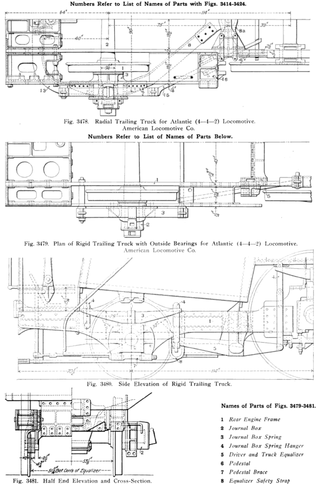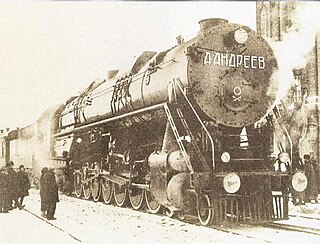
Under the Whyte notation for the classification of steam locomotives, a 2-10-4 locomotive has two leading wheels on one axle, usually in a Bissel truck, ten coupled driving wheels on five axles, and four trailing wheels on two axles, usually in a bogie. These were referred to as the Texas type in most of the United States, the Colorado type on the Burlington Route, and the Selkirk type in Canada.
The UIC classification of locomotive axle arrangements, sometimes known as the German classification or German system, describes the wheel arrangement of locomotives, multiple units and trams. It is used in much of the world, notable exceptions being the United Kingdom and North America.

In the Whyte notation, a 6-2-0 is a railroad steam locomotive that has an unpowered three-axle leading truck followed by a single powered driving axle. This wheel arrangement is associated with the Crampton locomotive type, and in the USA the single class were sometimes referred to as Cramptons.
Under the Whyte notation for the classification of steam locomotive wheel arrangements, a 2-10-10-2 is a locomotive with two leading wheels, two sets of ten driving wheels, and a pair of trailing wheels.

In the Whyte notation for classifying the wheel arrangement of steam locomotives, an 0-8-8-0 is a locomotive with two sets of eight driving wheels and neither leading wheels nor trailing wheels. Two sets of driving wheels would give far too long a wheelbase to be mounted in a fixed locomotive frame, so all 0-8-8-0s have been articulated locomotives of the Mallet type, whether simple or compound. In the UIC classification, this arrangement would be, refined to Mallet locomotives, (D)D. The type was sometimes called Angus in North America.
A 2-8-8-2, in the Whyte notation for describing steam locomotive wheel arrangements, is an articulated locomotive with a two-wheel leading truck, two sets of eight driving wheels, and a two-wheel trailing truck. The equivalent UIC classification is, refined to Mallet locomotives, (1'D)D1'. These locomotives usually employ the Mallet principles of articulation—with the rear engine rigidly attached to the boiler and the front engine free to rotate—and compounding. The 2-8-8-2 was a design largely limited to American locomotive builders. The last 2-8-8-2 was retired in 1962 from the N&W's roster, two years past the ending of steam though steam was still used on steel mill lines and other railroads until 1983.

Under the Whyte notation for the classification of steam locomotives, 4-2-2 represents the wheel arrangement of four leading wheels on two axles, two powered driving wheels on one axle, and two trailing wheels on one axle.

In the Whyte notation for the classification of steam locomotives by wheel arrangement, a 2-8-8-0 is a locomotive with a two-wheel leading truck, two sets of eight driving wheels, and no trailing truck.

In the Whyte notation for the classification of steam locomotive wheel arrangement, an 0-4-4-0 is a locomotive with no leading wheels, two sets of four driving wheels, and no trailing wheels. The arrangement is chosen to give the articulation of a locomotive with only the short rigid wheelbase of an 0-4-0, but with its weight spread across eight wheels, and with all the weight carried on the driving wheels; effectively a flexible 0-8-0. Articulated examples were constructed as Mallet, Meyer, BMAG and Double Fairlie locomotives and also as geared locomotives such as Shay, Heisler, and Climax types. A similar configuration was used on some Garratt locomotives, but it is referred to as 0-4-0+0-4-0. In the electric and diesel eras, the Bo-Bo is comparable and closest to the Meyer arrangement of two swivelling bogies.

On a steam locomotive, a trailing wheel or trailing axle is generally an unpowered wheel or axle (wheelset) located behind the driving wheels. The axle of the trailing wheels is usually located in a trailing truck. On some large locomotives, a booster engine was mounted on the trailing truck to provide extra tractive effort when starting a heavy train and at low speeds on gradients.

Under the Whyte notation for the classification of steam locomotives, a 4-8-8-2 is a locomotive with four leading wheels, two sets of eight driving wheels, and a two-wheel trailing truck.
Under the Whyte notation for the classification of steam locomotives, 0-8-2 represents the wheel arrangement of no leading wheels, eight powered and coupled driving wheels on four axles, and two trailing wheels on one axle.
In Whyte notation, 2-4-4-2 refers to a railroad steam locomotive that has two leading wheels followed by two sets of four coupled driving wheels and two trailing wheels.
A 4-4-6-4, in the Whyte notation for the classification of steam locomotives by wheel arrangement, is one that has four leading wheels followed by four coupled driving wheels, a second set of six coupled driving wheels and four trailing wheels.

The AA20 was a one-off steam locomotive constructed by the Soviet Union.

In Whyte notation for the classification of steam locomotives by wheel arrangement, an 0-4-4-2 is a locomotive that has no leading wheels, two sets of four driving wheels and two trailing wheels.

Under the Whyte notation for the classification of steam locomotives, 0-8-4 represents the wheel arrangement of no leading wheels, eight powered and coupled driving wheels on four axles, and four trailing wheels on two axles.

A triplex locomotive was a steam locomotive that divided the driving force on its wheels by using three pairs of cylinders to drive three sets of driving wheels. Any such locomotive will inevitably be articulated. All triplex locomotives built were of the Mallet type, but with an extra set of driving wheels under the tender. The concept was extended to locomotives with four, five or six sets of drive wheels. However, these locomotives were never built, except for one quadruplex locomotive in Belgium.
In the Whyte notation for the classification of steam locomotive wheel arrangement, a 2-4-4-0 is a locomotive with two leading wheels, two sets of four driving wheels, and no trailing wheels. Examples of this type were constructed as Mallet locomotives.

A 2-4-6-2 steam locomotive, in the Whyte notation for describing locomotive wheel arrangements, has a two-wheel leading truck, one set of four driving wheels, one set of six driving wheels, and a two-wheel trailing truck.













